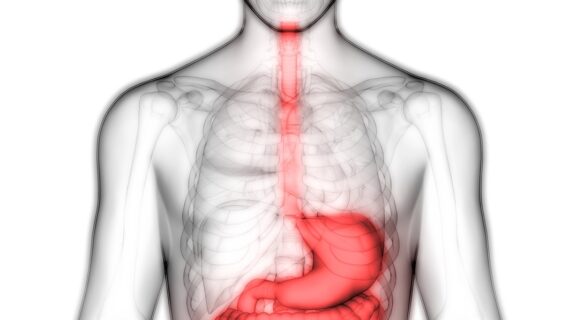Vitally important, the oesophagus is the tube that moves food from our mouths to our stomachs.
It has a protective mucous lining that keeps the tube healthy and safe from damage; however, if something continuously irritates the esophagus over a long period of time, you may experience difficulties in swallowing and some pain as the lining of the oesophagus becomes damaged.
This damage can lead to Barrett’s esophagus.
Barrett’s oesophagus is a condition where the lining of the tube becomes damaged and painful as stomach acids and chemicals wash back into the esophagus, damaging the surrounding tissue and changing the lining of the food pipe.
Barrett’s Oesophagus
Damage to the oesophageal lining can be caused by chronic acid reflux, which causes inflammation and a thickening of the lining.
Barrett’s oesophagus is a condition where an individual may experience a change in the cell structure of their oesophageal lining. This type of change is typically found in those suffering from chronic and untreated acid reflux.
It’s important to treat Barratt’s to prevent it from progressing to more serious complications.
Symptoms of Barrett’s Esophagus
As each individual is unique, not everyone will experience the same symptoms, and no clear symptom indicates wholly that an individual has Barrett’s.
Experienced healthcare professionals will carry out an endoscopy to assess the lining of the food pipe and check for Barrett’s. This is often followed by oesophageal pH monitoring and reflux testing to determine the level of acid exposure.
However, some of the most common symptoms of those diagnosed with Barrett’s include:
- Frequent heartburn
- Chronic acid reflux
- Regurgitation
- Difficulty swallowing
- Chest pain (less common)
Individuals with Barrett’s may also experience a narrowing of the esophagus due to scarring, as well as develop peptic ulcers caused by stomach acid. (Check out our latest post on Peptic Ulcers, what they are, and symptoms to look out for).
Please seek immediate help if you experience chest pains that won’t subside, you have difficulty swallowing, you are vomiting blood, passing black, tarry, or bloody stools, or you have noticed that you are losing weight unintentionally and at a dramatic rate.
If you have experienced any of these symptoms for over a period of 5 years, ask your GP about the possibility of Barrett’s Oesophagus.
Barrett’s Oesophagus Causes
The exact cause of Barrett’s syndrome is unknown, especially as we are aware that some people who have Barrett’s have what is known as silent reflux, i.e., no reflux symptoms.
However, often people who have been diagnosed with GERD – Gastroesophageal Reflux Disease, and this has been long-standing, means the higher the chance this could develop into Barratt’s Oesophagus.
It’s important to be aware that Barrett’s oesophagus can lead to a small risk of developing oesophageal cancer.
This is a small percentage. However, it’s important to continue having regular checkups with your healthcare professional, and if you have any concerns, to report these to your GP or consultant immediately.
Factors that can increase your risk of Barrett’s:
- Family history – if Barrett’s runs in the family and you begin to develop symptoms, this may lead to Barrett’s.
- Being male – males are more likely to be diagnosed with Barrett’s than females.
- Age – those with Barrett’s are typically over 55 years of age.
- Those diagnosed with GERD have a higher chance of this leading to Barrett’s syndrome.
- Lifestyle – smoking and being overweight are also factors that could increase the chances of Barrett’s.
Test for Barrett’s Oesophagus
Oesophageal pH monitoring is the most effective way to determine if someone has too much acid and chemicals damaging healthy tissues in the oesophagus.
In some instances, your GP or consultant may also refer you for an endoscopy, which can determine if a patient has Barrett’s oesophagus.
This test reflux allows healthcare providers to determine the level of tissue damage in the oesophagus and the most appropriate treatment for the individual.
In some cases, during the endoscopy procedure a small sample of the lining of the oesophagus is taken for biopsy and further examination.
Results from this may show:
- Short segment Barrett’s Oesophagus – the affected area is less than 3 cm long.
- Long segment Barrett’s Oesophagus – the affected area is longer than 3cm.
The biopsy will also be able to determine:
- No dysplasia showing on the oesophagus lining, cancer risk is low.
- Some dysplasia has been diagnosed (low-grade), which can indicate some risk of cancer.
- Significant dysplasia has been found (high-grade), which could indicate a high risk of cancer.
- Dysplasia is found through the biopsy (carcinoma) indicating it has progressed to cancer.
Please always consult a professional if you are concerned about your digestive health.
Action if you suspect Barrett’s Oesophagus
It’s essential with any gut health issues that you listen to your body, pay attention to symptoms, and seek treatment as soon as possible.
With regular checks and changes to diet and lifestyle, as well as acid-blocking medications, Barrett’s is treatable.
For further information from Functional Gut, please email admin@thefunctionalgutclinic.com
Disclaimer: The information is general and does not take into account your personal situation. This information is intended to provide general guidance and should not be used to self-diagnose or self-treat any medical condition. If your pain/symptoms persist, consult your doctor.

